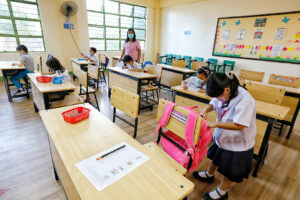Workforce skills critical if Philippines is to gain from ‘demographic dividend’

ANY RELIANCE on the so-called “demographic dividend” for economic growth will depend on the skills young workers acquire on the way to becoming the most numerous cohort of the working-age population, analysts said.
However, “this is nothing more than the demographic transition. For the first time in our history, we have a larger proportion of working age individuals instead of those who are still in schooling and those who are retired,” according to Leonardo A. Lanzona, director of the Ateneo Center for Economic Research and Development.
“The main question is how advanced are we in taking advantage of our demographic transition. Our Asian neighbors have been able to utilize this resource to the full by engaging in more industrialization and enhancing trade. So far, we don’t see much of this developing,” he added in an e-mail on Wednesday.
Finance Secretary Benjamin E. Diokno said on Saturday that the relative youth of the population will drive the consumer-driven economy forward.
“The young population, they consume a lot. (Domestic consumption is) actually the major mover or source of growth, plus investment. Investment… (creates) a lot of jobs, and along the way, you create a lot of consumption also,” Mr. Diokno said.
University of Asia and the Pacific Economist Bernardo M. Villegas said in an e-mail on Wednesday that the relative youth of the workforce remains a powerful driver.
“The greatest asset of the Philippines is our young and growing population. Thanks to a very youthful population (our median age is 24 years), our domestic market is very attractive to both domestic and foreign investors. Personal consumption is a growth driver,” he said.
According to the Philippine Statistics Authority (PSA), the youth labor force consisted of 7.3 million out of an estimated youth population of 20.14 million, or 36.25%, in May 2022.
New entrants to the labor force tagged between 15 and 24 years old increased by 11.12% from a month earlier to 999,000 in May.
The youth employment rate improved to 87.9% in May, against 85.5% a year earlier, and 87.7% a month earlier, according to the PSA.
But Mr. Villegas concurred that human capital development will be critical.
“The challenges we have to face are addressing the poor quality of basic education and the mismatch between what our institutions of higher education are producing as graduates and the actual demand of industry. There should be more emphasis on technical vocational courses than college diplomas,” Mr. Villegas said.
“The problem is that our industry is regionally concentrated in only NCR, Calabarzon and Central Luzon. Unless we push our industries to the other regions, we will remain a fragmented economy regionally. But without the needed skills in these regions, this goal will not be feasible. The priority in infrastructure which the previous and current administrations have indicated will not (deliver the expected) returns if we do not engage in skills development,” Mr. Lanzona said.
A silver lining from the pandemic could be a shift in how the young view technical vocational courses.
“The pandemic convinced many young people to forget getting a college diploma and take short courses in order to reskill, upskill and retool themselves so that they could be immediately employed in industries that are short of technical skills,” Mr. Villegas said.
“It will be the young who can be upskilled, reskilled and retooled to be employed in knowledge-based IT enterprises that will grow faster than the call centers, which are in danger of being replaced by Artificial Intelligence and Robotics,” he added. — Diego Gabriel C. Robles




